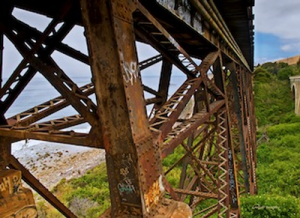As Induron Protective Coatings becomes more of an international company, it makes sense that we incorporate more and more global standards, guidelines and procedures into our written specifications. One such example of this trend is within the “T&D” coatings industry, or the painting of high-voltage electrical transmission lattice towers, steel poles and substation structures and equipment.
For decades, utilities had no guides or standards written specifically for T&D painting. Then coatings manufacturers or coatings knowledgeable engineers started writing specifications. Early specifications were very minimalist and had little to no test procedures, standards or even knowledge about how harsh environments can prematurely cause coatings to fail. Decades later, NACE/IEEE formed committees to consolidate the numerous standards into all-encompassing standards/specifications to help electric utilities properly specify and coat their structures.
For example, in 1983 a specification may only have referenced SSPC-SP2 Hand-Tool Cleaning and WFT/DFT readings during the application process with little or no references to measuring the many factors that can impact the coating after it is applied, such as ISO standards defining TOW (time-of-wetness), total amount of UV exposure, AQI (air quality index) etc.
Every possible environmental variable can now be measured and reported prior to writing a coatings specification. Also, globally there are many standards now being used to quantify and document the substrate prior to performing surface preparation to help perform the procedures that fit best to the situation. As is normally the case, more information helps define the best solution to your rusty structure.
Today, largely thanks to NACE/IEEE, there are relevant task groups and committees standards for T&D Coatings, such as TG395 and TG 386, who have written excellent standards to assess and repair both above (TG 395) and below-grade (TG 386) coatings.
In addition, ISO standards are helping to improve and expand the ability of electric utilities to properly assess the environment the structures are exposed to, the degree of corrosion and the proper surface preparation needed to create the best chance that the coating system will last for the longest possible time.
One of the ISO Standards includes most of the standards for this evaluation is ISO 12944. ISO describes the standard as follows:
ISO (the International Organization for Standardization) is a worldwide federation of national standards bodies (ISO member bodies). The work of preparing International Standards is normally carried out through ISO technical committees. Each member body interested in a subject for which a technical committee has been established has the right to be represented on that committee. International organizations, governmental and non-governmental, in liaison with ISO, also take part in the work. ISO collaborates closely with the International Electrotechnical Commission (IEC) on all matters of electrotechnical standardization.
Founded in 1947, Induron manufactures high performance coatings that serve a range of industrial applications, including the wastewater, transmission and distribution and groundwater storage industries. Learn more about us at www.Induron.com.





